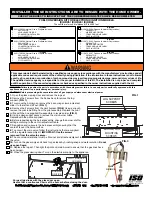
www.fmiproducts.com
106625-01F
4
clEaNING aND MaINTENaNcE
CREOSOTE
When wood burns slowly, it produces tar and
other organic vapors which, when combined
with expelled moisture, forms creosote.
Creosote vapors condense in relatively cool
chimney flue of a slow burning fire.
As a result, creosote residue accumulates on
flue lining. When ignited, this creosote makes
an extremely hot fire. Chimney should be
inspected at least twice a year during heat-
ing season to determine if creosote build-up
has occurred. If creosote has accumulated,
it should be removed to reduce risk of chim-
ney fire.
It is recommended that you use a
professional chimney sweep.
Removing Creosote
In order to remove creosote from flue, termi
-
nation cap must be removed.
1. Close damper before cleaning flue as fine
soot can become airborne in the home.
2. If termination is round top (3 feet of ex-
posed pipe with round cap) remove 3 sheet
metal screws that secure termination to last
section of pipe and lift off cap.
Wood Type
Density
Dogwood
0.70 - 0.79
Hickory
0.70 - 0.74
Oak
0.60 - 0.73
Beech
0.64 - 0.66
Hard Maple
0.58 - 0.65
Birch
0.55 - 0.64
Mulberry
0.59 - 0.63
Apple
0.58 - 0.62
Ash
0.57 - 0.61
Southern Pine
0.51 - 0.60
Elm
0.50 - 0.59
Walnut
0.52 - 0.55
Soft Maple
0.47 - 0.54
Cherry
0.50 - 0.52
Sycamore
0.49 - 0.52
Douglas Fur
0.45 - 0.51
Chestnut
0.42 - 0.44
Spruce
0.41 - 0.44
Hemlock
0.40 - 0.42
Redwood
0.33 - 0.40
Aspen
0.37 - 0.39
White Pine
0.35 - 0.37
WOOD SElEcTION
Selecting the right wood depends on your
preference for comfort, aroma and visual
image. If you want a constant heat output, a
short flame with a glowing coals type of fire,
select a hardwood. If you want a short hot fire
for damp and chilly mornings, select a softer
wood. The following chart is a guide to aide in
wood selection. Woods at the top of chart are
harder woods and those at bottom of chart are
softer. Aromatic woods are best from nut and
fruit trees such as hickory, apple, cherry, beech,
etc. Heat value from harder woods is better than
from softer. It is important to burn wood that has
been seasoned. Seasoning reduces moisture
content for a good steady fire and less creosote
output. The recommended length of time for
proper seasoning is about 1 year.
Never burn trash, plastics, gasoline, rubber,
industrial solvents, flammable liquids, naptha,
household garbage, material treated with
petroleum products, leaves, paper products,
cardboard or salt driftwood.
3. For square chase termination with pyra
-
mid cap, remove screws that secure top
at four corners.
4. Place termination top aside.
5. After cleaning is completed open damper
and collect debris in trash container. A
professional chimney sweep has all tools
and experience necessary to complete
this job.
6. Be certain to clean all loose debris from
termination before replacing.
7. Before installing a vented or vent-free gas
log set in a solid fuel burning fireplace,
chimney flue and firebox must be cleaned
of soot, creosote, ashes and loose paint
by a qualified chimney cleaner. Creosote
will ignite if highly heated. Inspect chimney
flue for damage. If damaged, operate
vent-free gas log heater with flue damper
closed.
8. Replace termination cap with screws.


























